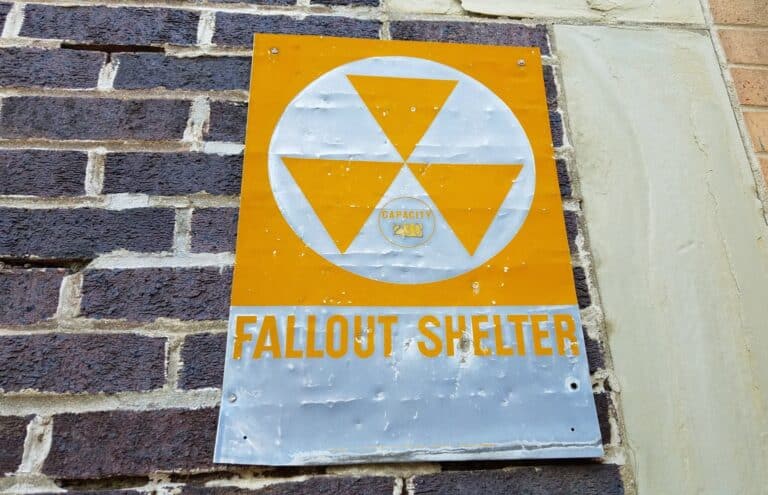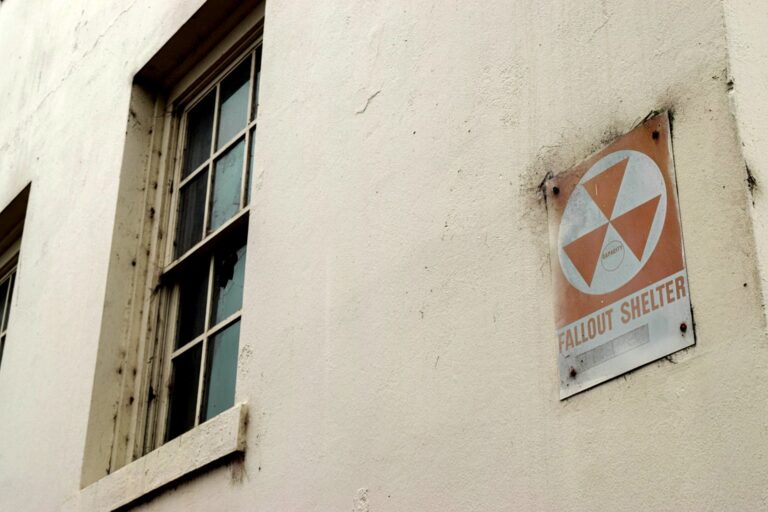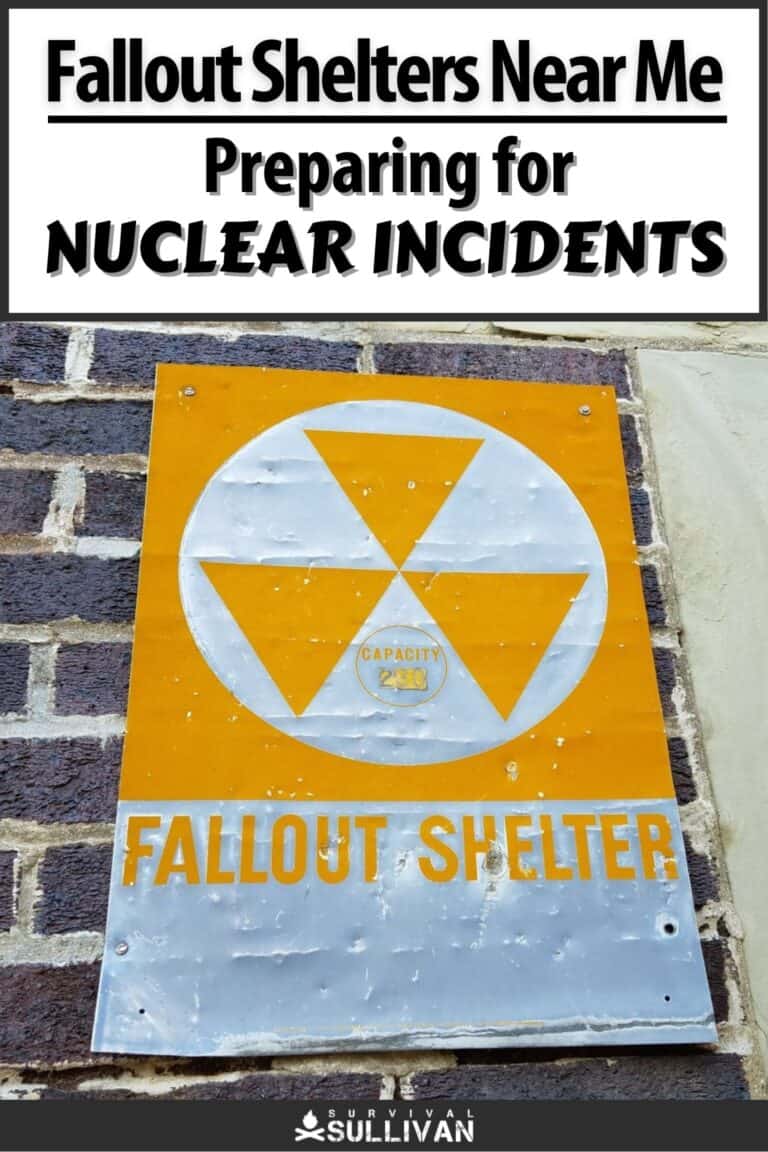With the increasing state of agitation the world is in, and that ever-present specter of nuclear proliferation among rogue states, terrorist groups, and other bad actors, nuclear incident preparedness is once again a major civic concern.

Of course everyone worries about the detonation of a nuclear weapon, but other nuclear threats such as dirty bombs or even nuclear power plant meltdowns could result in the widespread scattering of lethal nuclear fallout.
Although extremely deadly, this is one threat that is survivable with proper preparation and access to a suitable nuclear fallout shelter.
This article will serve as a guide that will help you locate serviceable fallout shelters near you, or construct or improvise your own if a proper one isn’t available.
Table of Contents
What is Nuclear Fallout Really?
Nuclear fallout is nothing more than debris generated by a nuclear incident that has been made dangerously radioactive.
Fallout is lifted into the air as particulates, dust- or sand-sized, in the aftermath of the event where it will drift on wind currents and settle back to the ground while still dangerously radioactive.
This fallout can contaminate and injure or kill people and animals, and make food, water, equipment, and medicine unusable.
Something like a nuclear warhead detonation close to the ground can generate a tremendous amount of fallout and scatter it over a wide area. You can play around with this nuke map tool and simulate a nuclear explosion in your area.
A dirty bomb can create highly concentrated fallout over a smaller area and even a nuclear power plant accident can likewise generate significant fallout in a localized area.
How Nuclear Fallout Can Hurt or Kill You
Nuclear fallout is directly harmful to people and animals in two ways. When it comes into contact with the skin or is ingested, and when it is nearby.
In either case, it will cause significant radiation contamination and likely long-term health effects.
This type of damage is caused by beta radiation, and though they are not deeply penetrating compared to the deadlier gamma rays they can still cause major and irreversible harm.
Low amounts of radiation damage can cause generalized illness, damage to your DNA, reproductive harm, and other relatively minor but long-term problems.
Serious doses of radiation can cause horrific radiation sickness, major damage to organs and all other tissues, bleeding from the mucous membranes, paralysis, and more. Overwhelming doses of radiation are fatal in hours or days.
Note that fallout does not have to be in contact with your skin or clothing, be ingested or inhaled to hurt you.
It can hurt you just by being close to you, and that is why we must keep as much material and as much distance between us and fallout as possible. That’s where a fallout shelter comes in.

So What is a Fallout Shelter?
A fallout shelter is any shelter, designed or improvised, that can serve as a safe space to keep fallout well away from you and anyone else inside the shelter.
Generally, they will be underground or partially underground and surrounded by thick layers of compressed dirt, concrete or other materials that will help to attenuate radiation.
Good shelters will also provide effective ventilation and have supplies inside to help survivors sustain until the radiation levels associated with fallout decrease.
A Fallout Shelter May Not Save You from a Bomb
The ideal fallout shelter will also serve as a protective enclosure against the devastating effects of a nuclear bomb, but this is not always strictly the case.
Nuclear warhead damage is highly variable depending upon the size of the device, the altitude of the detonation and how close the structure in question is to ground zero.
A fallout shelter might be entirely proof against radioactive fallout but vulnerable to the blast of a nuclear weapon- as most structures are!
You’ll always want to choose the closest and best fallout shelter that you can if you have any warning of a nuclear detonation, but you should also have a short list of multiple shelters in mind in case one is destroyed.
How Fast Do You Need to Get to a Fallout Shelter?
As quickly as possible, always, but preferably within 10 minutes of a nuclear incident whatever kind it may be.
The reason is that the vast majority of fallout will start to settle back to the ground within 10 minutes to half an hour.
This fallout will lose strength quickly and steadily over time but will be intensely radioactive in the immediate aftermath.
Seconds count when you are responding to any nuclear incident. Take action at once and do not hesitate.
How Long Must You Shelter in Place Post-Incident?
Preferably 72 hours, then try to tune in to instructions from authorities. The worst of the radiation will probably have subsided between 7 and 12 hours post-event, but it can remain intensely and dangerously radioactive for many days and even weeks afterwards.
Remember that radiation is cumulative, and ongoing exposure to fallout that is only mildly radioactive can turn into acute or lethal radiation sickness over time.
Exposure must always be minimized, and exposure to intense radiation avoided at all costs.
Your best bet is to be prepared for a stay of at least a week in your fallout shelter, and preferably longer if you have supplies and room.
For How Long Does Fallout Persist?
Since fallout is actually just physical material that has been lifted into the air and scattered by a nuclear incident, it does not magically vanish over time even as its inherent radioactivity steadily diminishes.
This means that fallout will stay where it is until it is cleaned up, though with enough time its radioactivity can subside into near harmlessness.
How Long Can a Person Live in a Fallout Shelter?
How long a person can live in their fallout shelter depends entirely on the situation at hand and survival necessities.
A properly stocked and sizable fallout shelter should be able to sustain every person in a group for at least a week and preferably several weeks or even longer.
This means that the shelter must account for food, water, needed medicines, hygiene requirements, ventilation, sanitation and more.
In all but the largest and most substantially equipped shelters this is not going to be a pleasant experience.
If you and your family are sheltering inside a tiny and cramped or improvised shelter it could be borderline nightmarish. That being said, it sure beats being dead!
This is why it is so important for you to take the time now to build or install a fallout shelter capable of meeting this standard, and stock it with the supplies that you know you and yours will need in the following days after a nuclear incident.
Public Fallout Shelters Exist Everywhere in the US
Fallout shelters aren’t just specially equipped basements or subterranean pods installed in the backyard…
In the aftermath of World War II and through all the long years of the Cold War, the US and other governments around the world started installing or at least selecting facilities in virtually every town and city to serve as shelters for citizenry in case of a nuclear attack.
Many of these shelters are clearly marked to this very day with the iconic and infamous nuclear trefoil, while others are designated only in a civic planning sense and known to authorities and planners.
Some of these buildings are nothing more than large multifamily or commercial buildings made of steel and concrete, excellent materials for blocking radiation with plenty of space near the interior to keep people safe.
Others are purpose-made subterranean shelters designed for the big one that never came.
It is definitely in your best interest to learn every comma single fallout shelter location in and around your home, workplace, town, and any other places you frequent.
Here’s a list of maps I could find, with fallout shelters in multiple cities:
1. New York Fallout Shelters Map
2. District of Columbia Fallout Shelters
You can also check the Community Shelter Plan Study for Washington here.
3. Milwaukee Fallout Shelters Map
4. Georgia Fallout Shelters Map
5. Kent County Fallout Shelter Locations
6. Detroit Fallout Shelters Map
7. Salt Lake City Fallout Shelter Location
8. Washtenaw County Fallout Shelters
Remember that minutes or even seconds may count when responding to a nuclear incident and reaching a shelter in time is highly likely to mean the difference between life and death.
Are Public Fallout Shelters Stocked with Supplies or Staffed?
No, at least any shelter that you are likely to have public and immediate access to.
Any supplies that you will have will either be brought into the shelter with you, brought by other people assuming they want to share, or pre-placed in a shelter that you have control over.
Although there are highly specialized blast and fallout shelters that are fully equipped, staffed, and supplied for the use of government personnel and VIPs, your average citizen is not going to have access to them when needed.
Remember that there will not be time to gather supplies when you are notified of a nuclear incident, be it a bomb or something else.
It is imperative you have a basic survival kit with you at all times or have your shelter pre-stocked.
What are Some Alternatives to Pre-Made Fallout Shelters?
Remember, a fallout shelter is a fallout shelter because it has the physical characteristics necessary to protect occupants from radioactivity.
This is accomplished by putting enough space between the exterior of the shelter (and the fallout accumulating on it) and the people inside.
Radiation is further attenuated simply by the mass and characteristics of the material the shelter is made from.
Because of this, other natural or man-made structures or formations like caves, mines, tunnels, and more may serve as adequate fallout shelters in a pinch.
Any shelter that can give you several feet at the minimum or many meters ideally between your habitation and the outside of the shelter is ideal, and it’s even more ideal if you have lots of dirt, concrete, or steel between you and the radiation.
This naturally means it’s a good idea to familiarize yourself with caves and minds in your area, just in case.
However, you should keep in mind that both caves and mines(here’s a map of inactive mines) are full of other hazards of their own, including sheer drops, cave-ins, accumulations of deadly gasses, dangerous insects or mammals, and more.
Neither should be your first choice, but if they are your only choice they are infinitely better than taking your chances with the certainly deadly fallout outside.
Is it Possible to Build Your Own Fallout Shelter?
Absolutely. An excellent fallout shelter can be made in an average home, especially one with a basement, assuming that your home survives a nuclear blast or whatever other incident has caused the fallout in the first place.
Serviceable fallout shelters can be made from something as simple as sandbags or earth bags arranged in a dugout or lean-to fashion and built thick enough to provide some standoff from fallout accumulating on the outside of the shelter.
As always, the very best protection is many feet of dense material between you and the fallout, along with protective measures in place to prevent the ingress of fallout.
Sealing up cracks, crevices, chimneys, vents, and other access points that could let fallout in is an important point of preparing any shelter.
We have several detailed articles for selecting and preparing your fallout shelter right here on Survival Sullivan.
How Can You Locate Fallout Shelters in Your Area?
You can locate fallout shelters in your area by keeping an eye out for a posted placard or engraved symbol that indicates one, or by contacting your local county or city government.
As mentioned above, sadly, much in the way of public shelter preparation has fallen by the wayside since the Cold War ended, but with the way things are going these programs are coming back around to front-of-mind for many officials.
If You Can’t Find or Build a Shelter, What Then?
If there’s a nuclear incident and you do not have your own shelter and cannot locate or cannot reach a designated shelter, you must take shelter in the nearest available structure. Anything, literally anything, beats being in the open when the fallout arrives.
Take cover in a shed, a motorhome, an automobile, or anything that will give you at least some protection and space from the fallout.
Always keep in mind that the thicker the material between you and the fallout, and the denser that material is, the better off you will be. Choose accordingly.


Tom Marlowe practically grew up with a gun in his hand, and has held all kinds of jobs in the gun industry: range safety, sales, instruction and consulting, Tom has the experience to help civilian shooters figure out what will work best for them.
